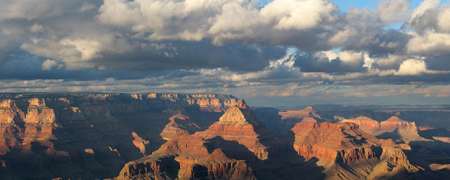Grand Canyon Seasonal Weather
With an elevation spanning from around 2000 feet to over 8000 feet, the Grand Canyon area experiences a variety of weather conditions. This weather variety includes cold winters and mild pleasant summers, moderate humidity, and considerable diurnal temperature changes at the higher elevations, with hot and drier summers at the bottom of the Grand Canyon along with cool damp winters. Summer thunderstorms and winter snowfall adds to the weather variety in this region.
- Grand Canyon Summer Weather in June, July and August
Summer temperatures on the South Rim are relatively pleasant with high temperatures generally in the 80s (27-32°C). Summer thunderstorms frequently occur with the potential for torrential rains, frequent lightning, and sudden flash floods.
- Grand Canyon Fall Weather in September, October and November
The summer heat gives way to a cooler but nonetheless pleasant fall period. The summer rains typically diminish in mid-September with a drier fall period. However, late summer thunderstorms or early winter snow storms have been known to take place during this transition season.
- Grand Canyon Winter Weather in December, January and February
Winter conditions on the South Rim can be extreme. Be prepared for snow, icy roads and trails, and possible road closures. Fog occasionally forms, however, it usually breaks up quickly by morning.
- Grand Canyon Spring Weather in March, April and May
By mid-April, the winter cold gives way to a warming and pleasant spring period. Spring is typically breezy to windy. Late season frosts and freezes are still a possibility. Although May is still the spring season, temperatures warm-up substantially by mid-May and the climate is similar to the summer season.
- Nearby Cities and Parks
For weather information at other destinations outside the Grand Canyon, check out our pages on nearby cities and nearby parks where you'll detailed information on weather and climate for each destination.





